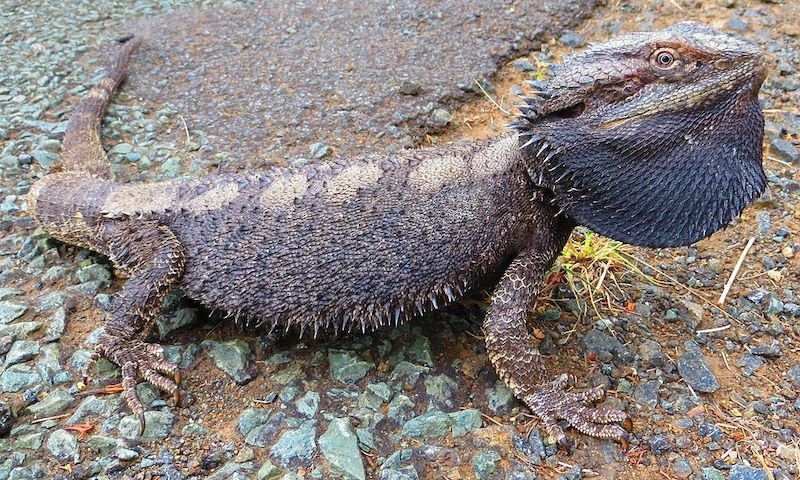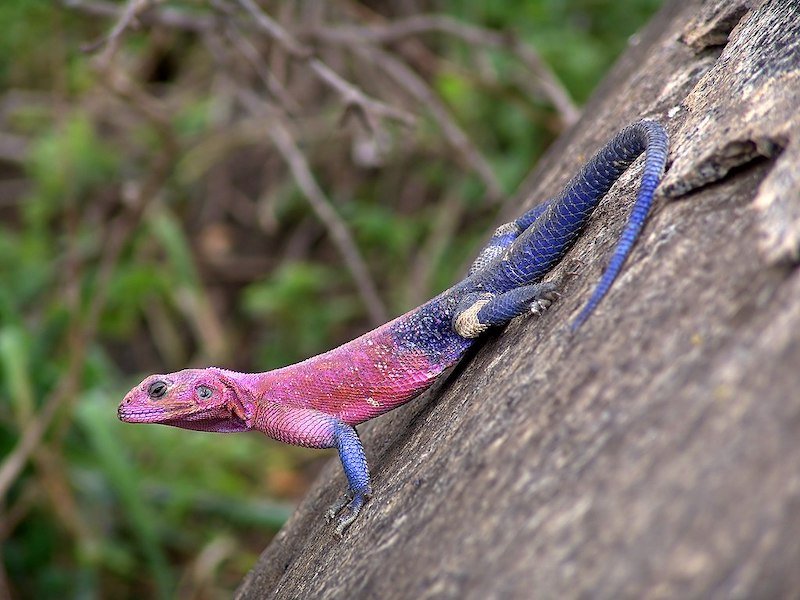Diverse Dragons?
Thomas Fuhrmann, CC BY-SA 4.0, via Wikimedia Commons
Agamidae
by Inspector Barry Mins on August 29, 2023Hey kids, welcome back to our series on the mysteries of created kinds. Last time, we got to meet the colorful members of the toucan kind. This week, we go from birds to lizards, but the colors are still there, along with some wild behaviors.

This week’s kind is found throughout Asia, Africa, and Australia, with a few species found outside that range. Their diet varies wildly, with some species being largely or completely vegetarian.1 Others vary their diet more broadly, taking in both insects and plants. Their habitat also varies widely, with some species preferring living in trees2 while others prefer the forest floor.3 Others prefer rocky outcrops where males and females live at different levels.4 Still others dig burrows in the dirt or sand and live there.5
Behavior in this group is unique and special. Included in this kind are the gliding lizards, with flaps of skin between their legs that they use to “float” in the air like a guided paper airplane.6 These gliding lizards will sometimes position their throat-fan in such a way that they can use the sunlight to enhance their display to members of the same species.7 Other members of the kind will play dead to escape predation.8
These lizards often are very colorful and communicative. At least one species has a complex group of signals to communicate with one other.9 In some species, color of the throat significantly influences mate choice and may also indicate when a female is ready to mate.10 Males sometimes change colors during the breeding season to attract mates.11
Mating in this kind is highly variable. Some species even reproduce parthenogenically.12 Parthenogenesis means that the females produce clones of themselves without needing to mate. Eventually, this leads to a species with only females, and there are several species within this kind that are completely parthenogenic13 and thus completely female.
Some members of the species lay eggs in shallow nests.14 Others give birth to live young.15 And at least some species’ sex is dependent on nest temperature.16 This means that the temperature of the nest determines if the hatchlings are male or female.
Has anyone figured it out yet? This week’s kind is the Agamidae—the agamid lizard kind. Popular members of this kind are the gliding lizards and the bearded dragons of Australia. Many members of this kind have unique colors and/or extensions of skin used for various purposes. Stay tuned for next week when we meet an adorable group of primates.
Try out this fun word search!
Clue
Your clue for the week is:
There are just 16 species of these primates. They are noted particularly for their large eyes relative to their size.
Ask a Question
Have you ever had a question about created kinds but didn’t know who to ask? Have you ever wanted to learn more about your favorite kind? Well, now you can! You can ask me, Inspector Barry Mins, a question! Have your parents help you fill out this form, and you might get your question answered in my column! If you have any questions about created kinds, feel free to send them my way!
Footnotes
- Saddiqa Qasim, Muhammad Rais, Faraz Akrim, and Tariq Mahmood, “A Study on Diet and Relationship of Indus Valley Spiny-Tailed Lizard (Saara hardwickii) with Vegetation,” The Journal of Animal and Plant Sciences 28, no. 3 (March 2018): https://www.researchgate.net/profile/Faraz-Akrim/publication/323627861_A_study_on_diet_and_relationship_of_indus_valley_spiny-tailed_lizard_Saara_hardwickii_with_vegetation/links/5ae2e262aca272fdaf8fca54/A-study-on-diet-and-relationship-of-indus-valley-spiny-tailed-lizard-Saara-hardwickii-with-vegetation.pdf.
- Leeann Reaney and Martin Whiting, “Picking a Tree: Habitat Use by the Tree Agama, Acanthocerus atricollis atricollis, in South Africa,” African Zoology 38, no. 2 (October 2003): 273–278, http://publicationslist.org/data/martin.whiting/ref-30/Reaney_Whiting_2003_AZ_agamas_pick_trees.pdf.
- S. R. Chandramouli, “Status and Microhabitat Preference of Otocryptis beddomii Boulenger, 1885 (Reptilia: Agamidae) in Ponmudi Hills Western Ghats, Kerala, India,” Taprobanica The Journal of Asian Biodiversity 1, no. 2 (October 2009): 107–110, https://www.researchgate.net/publication/265785660.
- Rajkumar Radder, Srinivas Saidapur, and Bhagyashri Shanbhag, “Population Density, Microhabitat Use and Activity Pattern of the Indian Rock Lizard, Psammophilus dorsalis (Agamidae),” Current Science 89, no. 3 (August 2005): 560–566, http://repository.ias.ac.in/54064/1/54064.pdf.
- Peter Cunningham, “Notes on the Diet, Survival Rate, and Burrow Specifics of Uromastyx aegyptius microlepis from the United Arab Emirates,” Asiatic Herpetological Research 9 (2001): 30–33, https://www.researchgate.net/publication/284662204.
- Jimmy McGuire and Robert Dudley, “The Cost of Living Large: Comparative Gliding Performance in Flying Lizards (Agamidae: Draco),” The American Naturalist 166, no. 1 (July 2005): 93–106, http://www.stevenpoe.net/uploads/3/7/3/4/37343605/draco.glide.pdf.
- Danielle Klomp, Devi Stuart-Fox, Indraneil Das, and Terry Ord, “Gliding Lizards Use the Position of the Sun to Enhance Social Display,” Biology Letters 13, no. 2 (February 2017): https://royalsocietypublishing.org/doi/epdf/10.1098/rsbl.2016.0979.
- Shahrudin Shahriza, “Defense Behavior of Gonocephalus grandis and Aphaniotis fusca (Squamata: Agamidae),” Phyllomedusa: Journal of Herpetology 17, no. 1 (June 2018): 153–156, http://dx.doi.org/10.11606/issn.2316-9079.v17i1p153-156.
- Rajkumar Radder, Srinivas Saidapur, Richard Shine, and Bhagyashri Shanbhag, “The Language of Lizards: Interpreting the Function of Visual Displays of the Indian Rock Lizard, Psammophilus dorsalis (Agamidae),” Journal of Ethology 24, no. 3 (April 2006): 275–283, DOI 10.1007/s10164-006-0192-8.
- Natasha LeBas and N. Marshall, “The Role of Colour in Signalling and Male Choice in the Agamid Lizard Ctenophorus ornatus,” Proceedings of the Royal Society of London B 267, (2000): 445–452, https://www.ncbi.nlm.nih.gov/pmc/articles/PMC1690562/pdf/10737400.pdf.
- Quah Evan, Choo Tse Chien, Muin Mohd Abdul, and Sah Shahrul Anuar Mohd, “Color Changes During Courtship and Mating of the Green Crested Lizard, Bronchocela cristatella (Kuhl, 1820) (Squamata: Agamidae) with a Discussion of Its Behavioral and Evolutionary Significance,” Russian Journal of Herpetology 19, no. 4 (2012): 303–306. Google Scholar.
- D. N. Malysheva, I. S. Darevsky, O. N. Tokarskaya, V. G. Petrosyan, I. A. Martirosyan, and A. P. Ryskov, “Analysis of Genetic Variation in Unisexual and Bisexual Lizard Species of the Genus Leiolepis from Southeast Asia,” Russian Journal of Genetics 42, no. 5 (2006): 463–467. https://doi.org/10.1134/S1022795406050012.
- Jesse Grismer, Aaron Bauer, L. Lee Grismer, Kumthorn Thirakhupt, Anchelee Aowphol, Jamie Oaks, Perry Wood, Chan Kim Onn, Neang Thy, Micheal Cota, and Todd Jackman, “Multiple Origins of Parthenogenesis, and a Revised Species Phylogeny for the Southeast Asian Butterfly Lizards, Leiolepis,” Biological Journal of the Linnean Society 113, no. 4 (December 2014): 1080–1093, https://academic.oup.com/biolinnean/article/113/4/1080/2415859.
- Syrus Cesar Decena, Michael Arguelles, and Dionesio Macasait, “Observation on the Reproduction and Nesting of the Mindanao Anglehead Lizard (Gonocephalus interruptus) in Northern Leyte, Philippines,” Herpetology Notes 15 (2022): 729–731. Google Scholar.
- Björn Lardner, Sing Yun Chin, and Ulrich Manthey, “Notes on Harpesaurus borneensis (Mertens 1924), A Live Bearing Agamid Lizard from the Lowlands of Borneo,” Russian Journal of Herpetology 17, no. 3 (2010): 231–235, https://www.researchgate.net/publication/267766105.
- Peter Harlow and Jennifer Taylor, “Reproductive Ecology of the Jacky Dragon (Amphibolurus muricanus): An Agamid Lizard with Temperature-Dependent Sex Determination,” Austral Ecology 25 (2000): 640–652, https://citeseerx.ist.psu.edu/document?repid=rep1&type=pdf&doi=cb38e4a9c20e968ea93ce60f324664f75ae668f4.
- © 2024 Answers in Genesis
- Privacy Policy
- Contact
- About



